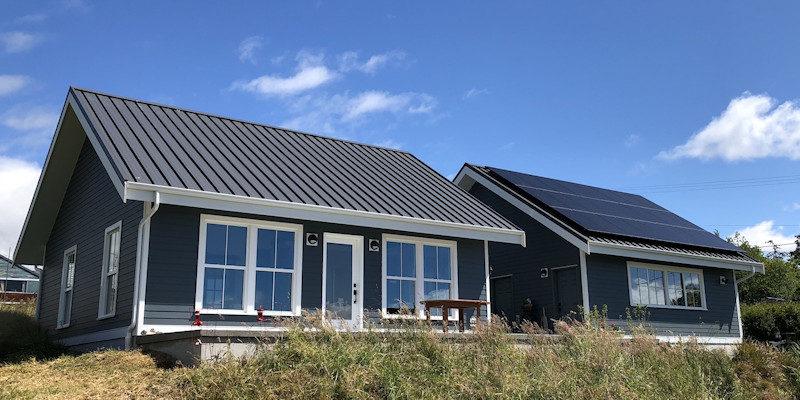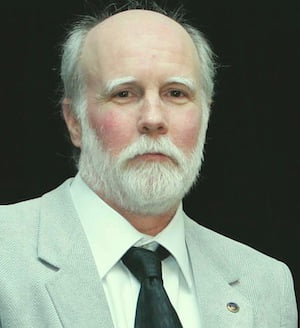
This article was written by Bruce Sullivan and originally posted on ZeroEnergyProject.org in September 2020.
Ted Clifton has been building energy-efficient homes for decades. More than 15 years ago he attended a lecture by green architect William McDonough. It inspired him to take the relatively small remaining step from energy efficient to zero energy. Since then he has provided plans and design services for 350 homes or more through Zero-Energy Plans. Another 20 to 30 homes have been built under his direction as general contractor at Clifton View Homes. Bruce Sullivan caught up with Clifton to interview him about his experience.
BS: What do you like best about zero energy homes?
TC: They are more comfortable than other homes, with better indoor air quality, and they are far more cost-effective.
BS: What is a key takeaway about how to design/build affordable, low-cost zero energy homes?
TC: Forget about all the goofy stuff everyone else is doing to come up with a wall system that is ”as good as SIPS,” and just learn how to build with SIPS. Spend all the time you save learning how to do everything else better.
BS: What design details are most important to strong energy performance?
TC: In our video, we identified twelve steps to designing and building zero-energy homes. Economy of everything is really the key.
BS: What have you learned about how to keep costs down?
TC: The KISS Principle; Keep It Simple, Stupid! And SIPs keeps it simple. Simple design is another main thing, and make sure you are taking advantage of everything that is free, such as correct use of your solar exposure, not just for solar panels, but for passive solar gains when you need them and proper shading when you don’t. Use natural convection, when you can, to allow air to circulate itself, keeping an even temperature throughout. Eliminate expensive systems with marginal benefits, such as HRVs in moderate climates. Do the math!
BS: Are there any new technologies for reaching zero energy cost effectively that you are excited about?
TC: I am really excited about some of the newer and better air-to-water heat pumps that can work down to outside temperatures well below zero, while providing both heat and domestic hot water with year-round COPs above 5.0. A good example is the Chiltrix CX34. It’s good to -15˚F and has a COP up to 5.92, depending on the climate zone.
BS: What advice would you give a client beginning the process?
TC: Think about what you really want: More time to enjoy, less time working, time to spend with family, less time doing maintenance. Keep it simple, and don’t let your house own you! Outdoor areas are cheaper to build, do not need to be conditioned, and will give you more pleasure for your dollar.
 BS: How would you advise designers and builders to reduce construction costs?
BS: How would you advise designers and builders to reduce construction costs?
TC: Simple design, use simple, tried-and-true methods and materials, such as SIPS for walls and roof, and pay attention to what nature gives you. Much of what you need is free! Start with a thought process. How much does it cost to think?
BS: What has been your experience with the financing and appraisal processes of zero energy homes you have sold? Do you have any suggestions for other builders?
TC: We have been fortunate that most of our customers have not had to fit into traditional lending situations. More often than not, however, the solar panels need to be left off the house until after the house can be finished and then re-financed, as the original appraisals rarely come up to what they need to be.
BS: Did you receive a third-party certification? If so, how important was that in your process?
TC: Always. This is vital to the process. A good rater not only measures the air leakage of the house, but provides help in tightening up your process, not just tightening up your homes. The energy rater is a vital member of the construction team.
BS: What policies are needed to advance the movement toward ZE as standard practice in the construction industry?
TC: Throw out the Energy Codes as we know them today. It is more cost-effective to get to true net-zero energy under the 2009 building code than it is with the more restrictive codes today. Instead, simply require that each house meets a zero-energy goal, and stop trying to tell us how to get there. Give us the freedom to innovate and improve.
BS: What else needs to happen to get zero energy homes into the mainstream?
TC: While zero energy homes are laudable, they are not the real bugaboo. We need to get gas out of our homes. All of our homes, not just the new ones. By changing every existing gas, oil, or other fossil-fuel furnace or water heater over to a heat pump as soon as the existing unit fails, over a period of about 20 years we would reduce the pollution and global-warming potential of homes and buildings down to pre-1960 levels, even if 100% of the additional electricity needed was produced by new natural gas-fired power plants.
Now to answer your question: People in the market to buy a home, need opportunities to check out a model zero-energy home. Once they experience it they will love it
Ted has won Housing Innovation awards from the US Department of Energy every year since 2013. You can see examples of his work on the USDOE Tour of Zero website.